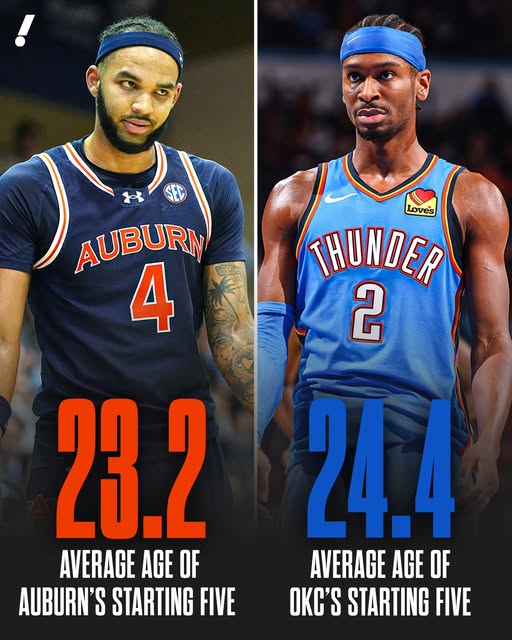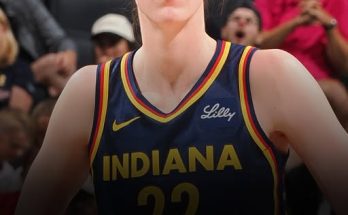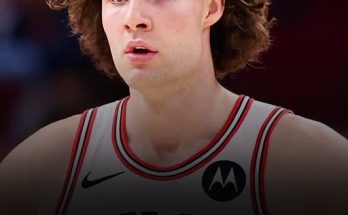Auburn’s starting lineup has become a fascinating topic of discussion among basketball enthusiasts, especially when drawing comparisons to the Oklahoma City Thunder’s lineup. The notion that a collegiate basketball team’s starting five could rival the age of an NBA squad is both amusing and intriguing. As we delve deeper into this phenomenon, it becomes evident that the dynamics of college basketball have been shifting over recent years, leading to more experienced, older players occupying significant roles on collegiate teams.
One of the most striking aspects of Auburn’s starting lineup is the average age of its players. While college basketball is often associated with young athletes fresh out of high school, Auburn has embraced a strategy that prioritizes experience and maturity. The result is a starting lineup composed of players who, in terms of age, could comfortably fit within the professional basketball scene. The comparison to the Oklahoma City Thunder only adds fuel to the debate about the evolving nature of college basketball and its resemblance to the professional league.
The Thunder, known for prioritizing youth and development, have one of the youngest rosters in the NBA. This strategic approach aligns with their rebuilding phase, where nurturing raw talent takes precedence over veteran presence. Meanwhile, Auburn’s decision to field a lineup with players of comparable age to OKC’s roster highlights the contrasting philosophies between college and professional basketball programs. The presence of older players in Auburn’s lineup is not merely coincidental but a reflection of the changing landscape in college sports, where athletes are increasingly taking advantage of additional years of eligibility.
The dynamics of player development and team composition in basketball have significantly evolved, particularly in the wake of new regulations and the impact of the global pandemic. The NCAA’s decision to grant an extra year of eligibility to student-athletes due to COVID-19 disruptions has played a pivotal role in this trend. Consequently, many players who would have otherwise graduated or moved on to professional endeavors chose to return to their college teams, adding an unexpected layer of experience and maturity to the collegiate basketball scene.
Auburn’s starting lineup, composed primarily of upperclassmen and even graduate students, reflects this trend. These players, who might have entered the professional circuit under normal circumstances, are now taking advantage of the opportunity to hone their skills and gain further exposure on the collegiate stage. This phenomenon has also altered the recruitment strategies of many college programs, as coaches now consider not only the talent of incoming freshmen but also the potential impact of experienced, older players who bring leadership and consistency.
From a strategic perspective, having older players on a college basketball team offers several advantages. Maturity, both physically and mentally, often translates to more consistent performance on the court. Players who have spent several years in the program are likely to have a deeper understanding of the playbook, better chemistry with teammates, and a more refined skill set. Additionally, these players tend to possess a heightened sense of responsibility and leadership, attributes that are invaluable during high-pressure games and postseason runs.
However, the juxtaposition of Auburn’s lineup with OKC’s also highlights a broader conversation about the direction of both college and professional basketball. While Auburn capitalizes on experience, the Thunder are committed to building a core of young, talented players who can grow together over time. This youth-centric approach often leads to growing pains, as young players navigate the challenges of transitioning to the professional level. In contrast, Auburn’s lineup stability, bolstered by older athletes, allows for a more immediate impact on the court.
The question then arises: which philosophy is more sustainable or effective in the long run? In college basketball, where turnover rates are high due to early departures for the NBA draft, the presence of older players can be a stabilizing force. Conversely, in the NBA, the ability to develop young talent and build a cohesive unit over several seasons is crucial for long-term success. OKC’s commitment to fostering a youthful core exemplifies this strategy, while Auburn’s reliance on experienced players represents a short-term approach geared towards immediate success.
This dynamic raises another intriguing question about the perception of college basketball in relation to professional leagues. Fans and analysts alike are beginning to notice how collegiate lineups are increasingly resembling professional rosters in terms of age and physical maturity. This shift challenges the traditional notion of college basketball as a stepping stone to the NBA, instead positioning it as a competitive arena where veteran athletes can dominate and influence the game’s outcome.
In many ways, the comparison between Auburn’s and OKC’s lineups symbolizes the convergence of two contrasting basketball ideologies. One emphasizes growth and potential, while the other capitalizes on readiness and experience. This contrast not only reflects differing priorities but also underscores the evolving nature of player development in modern basketball. As the sport continues to adapt to new challenges and opportunities, it is likely that more college programs will follow Auburn’s lead, opting for maturity over raw talent when assembling their lineups.
Yet, the debate does not end there. The impact of older college players on recruitment, team chemistry, and fan perception cannot be overlooked. Prospective recruits may view programs with older lineups as less favorable if they are seeking immediate playing time or a fast track to the NBA. On the other hand, teams with veteran rosters may be more appealing to athletes looking for mentorship and a chance to develop their game in a more structured, less volatile environment.
As Auburn’s unique approach continues to capture attention, other college programs may be inspired to reconsider their strategies. Whether this trend will become a lasting fixture or merely a temporary adjustment to the pandemic-era eligibility rules remains to be seen. Nonetheless, it serves as a fascinating case study in how adaptability and strategic decision-making shape the trajectory of basketball programs at all levels.
Ultimately, Auburn’s starting lineup, nearly matching the age of OKC’s, is more than just a quirky statistic. It is a reflection of broader changes in the basketball landscape, where experience and longevity are increasingly valued alongside youth and potential. As the sport continues to evolve, both college and professional teams will need to strike a balance between nurturing young talent and leveraging the stability and leadership that come with seasoned athletes. Only time will tell how this balance will shape the future of basketball, but for now, Auburn’s approach serves as a bold statement about the importance of experience in a fast-paced, ever-changing game.



